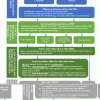Sign up to our newsletter Subscribe
Analysing Global Immunisation Expenditure

Sign up to our newsletter Subscribe


Why might differences arise between child and adult QALYs? In the UK, NICE’s science policy and research team is reviewing NICE’s recommendations on child utilities and QALYs. In Australia, the Medical Research Future Fund has announced it will fund research…

Why might differences arise between child and adult QALYs? In the UK, NICE’s science policy and research team is reviewing NICE’s recommendations on child utilities and QALYs. In Australia, the Medical Research Future Fund has announced it will fund research for the PBAC on the topic. This blog sets out a conceptual framework addressing five key issues in measuring and valuing children’s health as compared to that of adults.
Why might differences arise between child and adult QALYs? In the UK, NICE’s science policy and research team is reviewing NICE’s recommendations on child utilities and QALYs. In Australia, the Medical Research Future Fund has announced it will fund research for the PBAC on the topic. This blog sets out a conceptual framework addressing five key issues in measuring and valuing children’s health as compared to that of adults.
Value for money in the health care sector is usually assessed using cost effectiveness analysis. This involves weighing up the additional costs of treatment against the improvements in health that result from it – usually measured by quality adjusted life years (QALYs) gained. QALYs combine both length and quality of life.
This approach, and the health care decisions based on it, famously rest on the assumption that ‘a QALY is a QALY is a QALY’. That is, a QALY should always ‘mean’ the same thing – equate to an equivalent and comparable amount of health – regardless of the characteristics of those who happen to be affected by ill health or who benefit from treatment.
But what if those QALYs in some cases relate to children and in other cases to adults? Can QALY gains from health interventions be directly compared between children and adults?
Current approaches to health technology assessment (HTA), used around the world to inform health funding decisions, rely heavily on the comparability of the QALY metric. Budgets for child health are not usually ‘ring-fenced’, so decisions about how to spend limited health care budgets span both adult and child interventions. If adult and child QALYs are not strictly like-for-like, this would have implications for all conclusions about value for money – and for the allocation of funding to a wide range of child health care, including prevention (e.g. vaccines) and new treatments for childhood illness. An inability to capture QALYs for children in a way that makes them comparable to adult QALYs could undermine efficiency and fairness in funding decisions.
This issue has recently come to the fore. In the UK, NICE’s science policy and research team is reviewing NICE’s recommendations on child utilities and QALYs, and will make recommendations to the ongoing NICE methods review.
In Australia, the Medical Research Future Fund (MRFF) has announced it will fund research to address questions arising from its HTA body, the Pharmaceutical Benefits Advisory Committee (PBAC) about how child health should be measured and valued, including addressing this question:
“Are quality-adjusted life years (QALYs) derived in paediatric populations comparable to those derived in adult populations? If not, how should policy makers make decisions if the two metrics are not directly comparable?”
So, why might differences arise between child and adult QALYs?
Much of the focus on this topic amongst health economists has been on ‘utilities’ – the quality of life values used to weight length of life in calculating QALYs – and the question of whether these values mean the same thing for child as for adult health states. There are some very challenging aspects of valuing child health states, as a recent paper by Rowen et al (2020) explains.
But while this is important, it is far from the whole picture. QALYs involve both measuring quality of life and valuing it. Below, we provide a conceptual framework setting out the potential sources of differences in QALY estimates for children and adults. It is summarised in the Figure linked below.
The ‘quality of life’ part of QALYs is measured by a person (or someone acting as their proxy) reporting how they feel, using structured questionnaires (called ‘patient reported outcomes’ or PROs). The development of PROs involves deciding what is being measured (e.g. health status? health-related quality of life? quality of life more generally?); what aspects of that are most important; how the levels of problems on each aspect are labelled/described (e.g. words? numbers? smiley faces?), and how responses are sought (e.g. a Likert scale? visual analogue scale? tick boxes?).
Which aspects of health and quality of life are perceived to be the most relevant and important to children, and what words/other means are best used to describe them, might be different to that for adults. For example, the way that poor health affects daily activity might be quite different between children and adults – and could be different across stages of child development. So PROs developed for self-completion by children may measure different things than adult PROs, and may measure those things in different ways. The ISPOR good practices report on pediatric PROs provides a good overview, and highlights the need to design PROs in way that is appropriate to the developmental stage.
There are a number of childhood PROs. EQ-5D-Y and CHU9D are both concise, general PROs aimed at children, that are accompanied by values, but each measures somewhat different things. So there is also the question of whether the QALY estimates produced by each would be the same. This issue isn’t specific to children, it also arises for QALYs estimated from the wide variety of PROs for adults.
Measuring self-reported health in children, even with a well-designed PRO, will still be too difficult for very young children and children with developmental or cognitive limitations. In these cases, PROs can be completed by parents, caregivers or health care professionals on behalf of the child. However, this relies on them perceiving, understanding and accurately recording the child’s subjective experience of their health.
Where children can fill out the PRO, the answers they give will depend on how they perceive their problems: a child’s understanding of what is ‘normal’ and what is a ‘problem’ might be different from an adult’s. For example, children are known to perceive time differently to adults, which may impact their reporting of chronic versus acute health problems. Responses might also be affected by how readily children adapt both to health problems and to improvements in health from treatment. Equally, responses from adults acting as proxies for children might be affected by the adult’s understanding of the prognosis. And children of different ages and backgrounds might have different ‘response styles’ in how they record their health on specific sorts of questions.
The issues in (1) and (2) combine to mean that what is being measured in terms of health, and how it is measured, will differ between adult PROs and child PROs.
For any given health state described by a PRO for children, a quality of life weight is needed so QALYs can be calculated. All the usual challenges faced in valuing quality of life for adults apply here too: what stated preference method is best? What sub-set of states to value? How to model the values? But aside from these common issues there are additional challenges which add to the complexity when valuing child health states.
Some of the methods traditionally used in valuation are problematic when valuing child health. For example, adults asked to value poor health in a child using the time trade-off (TTO) are reluctant to ‘trade’, and trade-off fewer years of life, so we end up with higher values for bad health states for children compared to those for adults. Length of life/survival seems to be a more important consideration than quality of life when adults value child health states, begging the question of whether the fundamental relation between the two parts of the QALY (length and quality) is different for children and adults.
Then there’s the question of who should do the valuing. With adult health states, it’s adult members of the general public who complete these valuation tasks. But that is because of a value judgement, generally accepted by decision making bodies such as NICE and PBAC, that it should be members of the general public (as taxpayers, and people who benefit from publicly funded health care) who provide these values, as opposed to any argument that adults should value health states experienced by adults. That same principle might suggest that adults – as opposed to children – provide the values for pediatric PROs. But there is an issue here: older children also work and pay tax and are also beneficiaries of publicly funded health care, so shouldn’t they at least form a part of the ‘general public’ sample? We know from recent research that adolescents are capable of providing reasoned responses to DCE valuation tasks – see Mott et al (2019) and Dalziel et al (2020). At the very least this begs the question of who comprises the ‘general public’ for such purposes and, where it is feasible to obtain values from children, what the age cut-off should be for including them when we produce ‘average’ values to use in decision making.
If adults are asked to value the health states described by pediatric PROs, this adds further challenges. In contrast to the situation in which adults are valuing adult health states, it will be obvious that it is child health states they are being asked to ‘imagine’ when valuing a pediatric PRO (e.g. ‘some problems with play and homework’). Should the adult value that health state imagining their self as a child? Or imagining their own child? Or some random/hypothetical child? How old should this ‘hypothetical child’ be that we are imagining? Will results be different if we ask adults to imagine a 2 year old, rather than a 10 year old?
This is still largely uncharted territory – the questions are becoming clear (Rowen et al 2020) but there is no consensus on the answers. And that is because these issues aren’t just ‘technical’ ones, but involve some hard thinking about the value judgements at stake.
To calculate QALYs, length of time spent in a given health state is multiplied by the quality of life utilities/’values’. Values for pediatric PROs are typically obtained by asking adults to imagine the health problems experienced by a child of a particular age (e.g. the EuroQol Group plans to use ‘10 years of age’ in valuing the EQ-5D-Y, and 10 years has been very widely used in valuing child PROs). But is it OK to apply those values, in cost effectiveness analysis, to the health problems self-reported on a PRO by, say, a 5 year old? or a 15 year old? Might the values, and QALY estimates, be different if we had values relating specifically to those ages?
Preventing or treating a health problem in childhood produces benefits – additional QALYs – that often carry on into the child’s future lifetime. Where, in modelling the cost effectiveness of this, do we switch from estimating QALYs using child PROs/values to adult PROs/values?
Finally, regardless of how QALYs are measured and valued for children, there is the question of whether decision makers should regard the QALYs gained by children as being of higher priority, or having special merit, compared to QALYs gained by adults. HTA bodies like NICE and PBAC allow considerations other than cost effectiveness to be taken into account. Should QALYs be ‘weighted’ in some way to reflect this? What would these weights be based on – social preferences? The opinions of decision makers? There is some evidence that the public value child QALYs more highly, but this may vary by health condition and age, further complicating matters.
Some of the challenges with PRO measurement and valuation for children also apply to measures of adult health. But the issues are more complex when the health (and other) benefits involve children. None of these issues are insurmountable, but they involve making value judgements that go beyond the things economists should be deciding on. It is crucial that researchers working on these questions engage with decision makers, to ensure that the way child QALYs are measured and valued is a good ‘fit’ with the principles and social value judgements used in HTA and health policy. These might not be the same in every country, so there may not be any ‘one size fits all’ solution!
For more information, please contact: Professor Nancy Devlin, University of Melbourne & Senior Fellow, Office of Health Economics.
Nancy Devlin, Professor of Health Economics, University of Melbourne & Senior Research Fellow, Office of Health Economics
Richard Norman, Professor of Health Economics, Curtin University
Julie Ratcliffe, Professor of Health Economics, Flinders University
Brendan Mulhern, Senior Researcher, CHERE, University of Technology Sydney
Kim Dalziel, Associate Professor, Health Economics Unit, University of Melbourne
Gang Chen, Associate Professor, Centre for Health Economics, Monash University.
Rosalie Viney, Director of CHERE, University of Technology Sydney
Related research
Mott, D.J., Shah, K.K., Ramos-Goñi, J.M., Devlin, N.J. and Rivero-Arias, O (2019) Valuing EQ-5D-Y health states using a discrete choice experiment: do adult and adolescent preferences differ? OHE Research Paper. London: Office of Health Economics.
Shah, K.K., Ramos-Goñi, J.M., Kreimeier, S. and Devlin, N.J (2020) Anchoring Latent Scale Values for the EQ-5D-Y at 0 = Dead. OHE Research Paper. London: Office of Health Economics.
Rowen, D., Rivero-Arias, O., Devlin, N., Ratcliffe, J. (2020) Review of Valuation Methods of Preference-Based Measures of Health for Economic Evaluation in Child and Adolescent Populations: Where are We Now and Where are We Going? PharmacoEconomics.
An error has occurred, please try again later.
This website uses cookies so that we can provide you with the best user experience possible. Cookie information is stored in your browser and performs functions such as recognising you when you return to our website and helping our team to understand which sections of the website you find most interesting and useful.
Strictly Necessary Cookie should be enabled at all times so that we can save your preferences for cookie settings.
If you disable this cookie, we will not be able to save your preferences. This means that every time you visit this website you will need to enable or disable cookies again.
This website uses Google Analytics to collect anonymous information such as the number of visitors to the site, and the most popular pages.
Keeping this cookie enabled helps us to improve our website.
Please enable Strictly Necessary Cookies first so that we can save your preferences!



